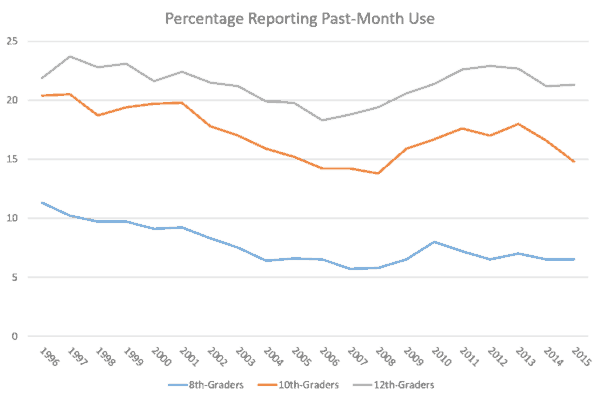Most of the Cornerstone blog articles we post are about the future and pending medical advances. However, today, we will instead take a quick look at the present, specifically at the national conversation around medical cannabis. As more states continue to legalize medical and recreational cannabis, the bulk of conversation centers on how to navigate this collective policy change to produce the greatest good and smallest harm for society as a whole. However, while 2016 has certainly been an outstanding year for medical cannabis and cannabinoid research, reefer madness is still alive and well, and opposition remains strong.
For exhibit A, the report that is setting the internet abuzz, the University of Western Australia published a press release linking cannabis use to gene mutation. To quote the article:
“‘Through our research we found that cancers and illnesses were likely caused by cell mutations resulting from cannabis properties having a chemical interaction with a person’s DNA,’ Associate Professor Stuart Reece said.”
As if this isn’t scary enough, the article then suggests that these mutations are passed to offspring. Yikes. Following this line of thought, by consuming cannabis, individuals may inadvertently be giving their children cancer!
Fortunately, cannabis science luminary Ethan Russo stepped in to clarify and debunk the report. In an interview for the East Bay Express, Ethan noted, “This report is based on a foundation of falsehoods. Cannabis is not mutagenic (productive of mutations in DNA)…Countless animal studies and human epidemiological studies support its relative safety in this regard.”
Despite Russo’s well-educated claim, we were none-the-less curious. Regardless of previous data, we’re always interested to see the results of new studies, so we took a look at the statement itself. As it turns out, there was no new data; no experiments were actually conducted. When the authors said “through our research”, what they apparently meant was, “through reading other scientific reports and drawing our own opinion.” Although this type of survey writing is common in the medical community to help observe and establish trends in research, it is relatively uncommon for a large university to publicize. Additionally, it goes to show how little accountability opponents of cannabis sometimes have. The lead “research” professor of this study is currently a professor of Psychiatry and Clinical Sciences at the university. He also holds a medical degree and advocates for faith-based healing on occasion. Although this current statement on cannabis has caught public attention, Reese has issued similar over-reaching statements about other substances. And yet, there is nothing legally wrong with him doing so.
Aside from blatant mistruth, another common tactic used to block medical cannabis legislation is the idea that legalizing cannabis sends the wrong message to youth. As Forbes noted recently, when California became the first state to recognize cannabis as a medicine, the head of the DEA stated, “How can we expect our children to reject drugs when some authorities are telling them that illegal drugs should no longer remain illegal, but should be used instead to help the sick?”
Aside from the fact that this statement centers on legality as opposed to health, the basic notion is understandable; will helping individuals have safe access to medical cannabis also mean greater access and abuse for youth? What happens when children see their parents consuming cannabis legally and even medically? What happens when children see legal use in mainstream media?
Great question. As it turns out, adolescent cannabis use declines! Below is a copy of data from the Monitoring the Future. Monitoring the Future is a nation-wide ongoing study that polls roughly 50,000 8th,10th, and 12th grade students every year with a focus on drug abuse.

As Forbes points out, and as readers can see above, use has trended downward for all three grades surveyed since 1996 when medical cannabis first become legal. While it is not impossible that other factors are at play, the bottom line is that legalizing medical cannabis has not led to the slippery slope of a nation of cannabis-dependent adolescents.
Of course, misinformation exists on both sides of the conversation. For every overzealous researcher or politician, there is a supporter of cannabis that goes too far. Due to the success of using cannabinoids to kill cancer cells, some individuals are mistakenly under the impression that consuming cannabis will prevent cancer. At Cornerstone, we would advise that readers take a much more unbiased position in evaluating risk and benefit of cannabis use. Regardless of the future of cannabis, however, the time has come to shed the image of cannabis as a dangerous drug that threatens to unravel the tapestry of modern society. Countless studies have proven that cannabis is safe and effective for a host of medical conditions, and moreover, nation-wide usage trends are not spiraling out of control. At this point, society has no reason to feel threatened, and even non-users should support the current medical cannabis research boom. More data and information will allow us to make better-educated choices for society.
Works Cited
Downs, David. “‘Cannabis Damages DNA’ Claim Debunked By Leading Researcher Ethan Russo.” East Bay Express. 31 May 2016. EastBayExpress.com. Web. 4 June 2016 Accessed.
Sulum, Jacob. “As Fear and Intolerance of Marijuana Declined, So Did Adolescent Use.” Forbes. 2 June 2016. Forbes.com. Web. 4 June 2016 Accessed.

